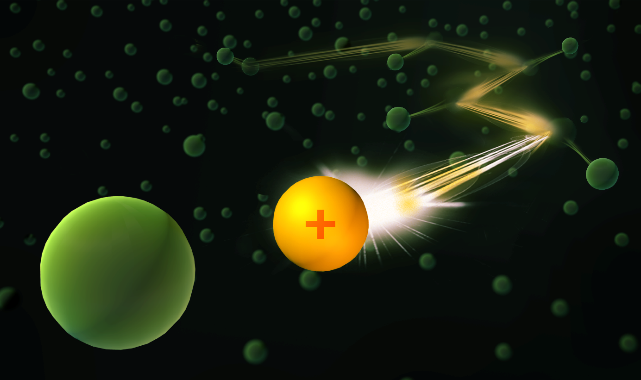Transport processes are ubiquitous in nature but still raise many questions. The research team around Florian Meinert from the 5th Institute of Physics at the University of Stuttgart has now developed a new method that allows them to observe a single charged particle on its path through a dense cloud of ultracold atoms. The results were published in the prestigious journal Physical Review Letters and are subject in a Viewpoint of the accompanying popular science journal Physics.
Meinert‘s team uses a so called Bose Einstein condensate (BEC) for their experiments. This exotic state of matter consists of a dense cloud of ultracold atoms. By means of sophisticated laser excitation, the researchers create a single Rydberg atom within the gas. In this giant atom the electron is a thousand times further away from the nucleus than in the ground state and thus only very weakly bound to the core. With a specially designed sequence of electric field pulses, the researchers snatch the electron away from the atom. The formerly neutral atom turns into a positively charged ion that remains nearly at rest despite the process of detaching the electron. In a next step, the researchers use precise electric fields to pull the ion in a controlled way through the dense cloud of atoms in the BEC. The ion picks up speed in the electric field, collides on its way with other atoms, slows down and is accelerated again by the electric field. The interplay between acceleration and deceleration by collisions leads to a constant motion of the ion through the BEC.

The trajectory of a positively charged ion (yellow) through the BEC (green) can only be visualized artistically yet. The ion microscope, which is already being developed at the institute promises to make this path directly visible in the future with a resolution of below 200 nanometer. Illustration: Celina Brandes
„This new approach allows us to measure the mobility of a single ion in a Bose Einstein condensate for the very first time“ Thomas Dieterle, PhD student on the experiment, is pleased. The researchers’ next goal is to observe collisions between a single ion and atoms at even lower temperatures, where quantum mechanics instead of classical mechanics dictates the processes. „ In future, our newly created model system - the transport of a single ion – will allow for a better understanding of more complex transport processes that are relevant in many-body systems, e.g. in certain solids or in superconductors“ Meinert is sure. These measurements are also an important step on the way to investigate exotic quasi-particles, so-called polarons, which can arise through interaction between atoms and ions.
The neighboring lab at the institute already works on an ion microscope that will allow to directly observe collisions between atoms and ions. While an electron microscope uses negatively charged particles to create an image, this is what happens in an ion microscope with positively charged ions. Electrostatic lenses deflect ions similar to light rays in a classical optical microscope.
Physical Review Letters, 126, 033401 - published on 19 January 2021
| Contact | Dr. Florian Meinert | Universität Stuttgart | 5. Pysikalisches Institut | f.meinert [at] physik.uni-stuttgart.de |
|---|


